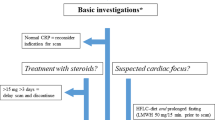Abstract
Purpose
To evaluate the frequency of emergency diseases that were detected unexpectedly using FDG-PET/CT.
Materials and methods
Interpretation reports for 11,663 FDG-PET/CT studies in our hospital were retrospectively reviewed. Patients with major emergency diseases were extracted according to the following exclusion criteria: (1) relevant findings had been recognized prior to the PET/CT; (2) an intervention or operation that may have been relevant to the present findings was performed within 1 month prior to the PET/CT; and (3) the clinical course could not be investigated sufficiently (e.g., in cases where the patients were introduced from other hospitals).
Results
Forty-one patients (0.35%) with unexpected emergency diseases were identified. The most frequent disease was pneumothorax (8 patients), followed by chronic subdural hematoma (CSH) (7 patients), ureteral stone (7 patients), and abdominal aortic aneurysm (AAA) with a dirty fat sign or a high-attenuation crescent sign visualized on CT (4 patients). Nine patients (2 pneumothorax, 3 CSH, 1 cerebral hemorrhage, 1 acute cholecystitis, 1 acute pancreatitis, and 1 acute appendicitis) were hospitalized and/or underwent therapeutic intervention within 1 week after the PET/CT.
Conclusion
Although rare, an unexpected emergency disease requiring urgent management can be detected using FDG-PET/CT in oncology patients.




Similar content being viewed by others
References
Nicherson J, Fairbank J, Ebert G. Incidental finding of subacute hematoma on PET/CT following cardiac cathetarization. Clin Nucl Med. 2007;32:456–7.
Kim DW, Kim MH, Kim CG. Incidental detection of urinary leakage on FDG PET/CT imaging for staging of gastric cancer. Clin Nucl Med. 2016;41:217–8.
Yamaga E, Tsunoda A, Kudo T, Toriihara A, Tateishi U. A case of incidental chronic subdural hematoma detected by FDG-PET/CT for evaluation of external auditory canal carcinoma. Nucl Med Clin. 2015;48:82–3 (Japanese).
Hanna TN, Shekhani H, Zygmont ME, Kerchberger JM, Johnson JO. Incidental findings in emergency imaging: frequency, recommendations, and compliance with consensus guidelines. Emerg Radiol. 2016;23:169–74.
Kelly ME, Heeney A, Redmond CE, Costelloe J, Nason GJ, Ryan J, et al. Incidental findings detected on emergency abdominal CT scans: a 1-year review. Abdom Imaging. 2015;40:1853–7.
Fakler JK, Ozkurtul O, Josten C. Retrospective analysis of incidental non-trauma associated findings in severely injured patients identified by whole-body spiral CT scans. Patient Saf Surg. 2014;8:36. doi:10.1186/s13037-014-0036-3.
Rogers AJ, Maher CO, Schunk JE, Quayle K, Jacobs E, Lichenstein R, et al. Incidental findings in children with blunt head trauma evaluated with cranial CT scans. Pediatrics. 2013;132:e356–63.
Bruzzi JF, Truong MT, Marom EM, et al. Incidental findings on integrated PET/CT that do not accumulate 18F-FDG. Am J Roentgenol. 2006;187:1116–23.
Osman MM, Cohade C, Fishman EK, et al. Clinically significant incidental findings on the unenhanced CT portion of PET/CT studies: frequency in 250 patients. J Nucl Med. 2005;46:1352–5.
Lumbreras B, Donat L, Hernandez-Aguado I. Incidental findings in imaging diagnostic tests: a systematic review. Br J Radiol. 2010;83:276–89.
Mehard WB, Heiken JP, Sicard GA. High-attenuating crescent in abdominal aortic aneurysm wall at CT: a sign of acute or impending rupture. Radiology. 1994;192:359–62.
Sueyoshi E, Sakamoto I, Kawahara Y, Matsuoka Y, Hayashi K. Infected abdominal aortic aneurysm: early CT findings. Abdom Imaging. 1998;23:645–8.
Block J, Jardanov MI, Stack LB, Thurman RJ, editors. The atlas of emergency radiology. New York: McGraw Hill Education; 2013.
Krishnam MS, Curtis J, editors. Emergency radiology. New York: Cambridge University Press; 2010.
Soto JA, Lucey BC, editors. Emergency radiology: the requisites. Philadelphia: Mosby Elsevier; 2009.
Pope TL Jr, Harris JH Jr, editors. Harris & Harris’ the radiology of emergency medicine. 5th ed. Philadelphia: Lippincott Williams & Wilkins; 2013.
Bobbio A, Dechartres A, Bouam S, et al. Epidemiology of spontaneous pneumothorax: gender-related differences. Thorax. 2015;70:653–8.
Yang W, Huang J. Chronic subdural hematoma: epidemiology and natural history. Neurosurg Clin N Am. 2017;28:205–10.
Baechli H, Nordmann A, Bucher HC, Gratzl BO. Demographics and prevalent risk factors of chronic subdural haematoma: results of a large single-center cohort study. Neurosurg Rev. 2004;27:263–6.
Jalalzadeh H, Indrakusuma R, Planken RN, Legemate DA, Koelemay MJW, Balm R. Inframmation as a predictor of abdominal aortic aneurysm growth and rupture: a systematic review of imaging biomarkers. Eur J Vasc Endovasc Surg. 2016;52:333–42.
Author information
Authors and Affiliations
Corresponding author
Ethics declarations
Conflict of interest
The authors declare that they have no conflict of interest.
Funding
We have no grant funding nor any financial relationships to disclose.
Informed consent
Our institutional review board has approved this retrospective study, and the need for written informed consent was waived (IRB approval number: M2016-181).
About this article
Cite this article
Toriihara, A., Yamaga, E., Nakadate, M. et al. Detection of unexpected emergency diseases using FDG-PET/CT in oncology patients. Jpn J Radiol 35, 539–545 (2017). https://doi.org/10.1007/s11604-017-0664-5
Received:
Accepted:
Published:
Issue Date:
DOI: https://doi.org/10.1007/s11604-017-0664-5




